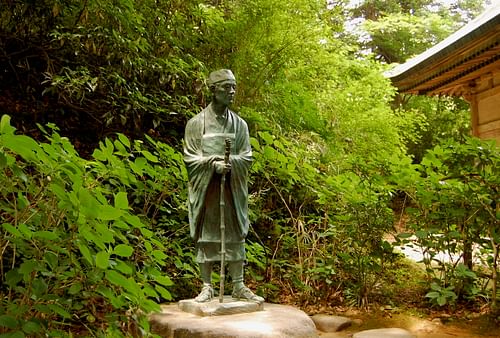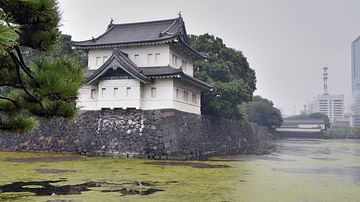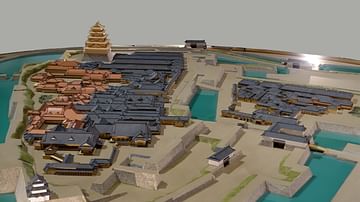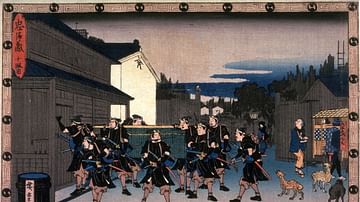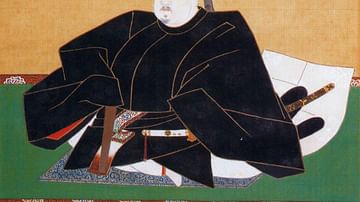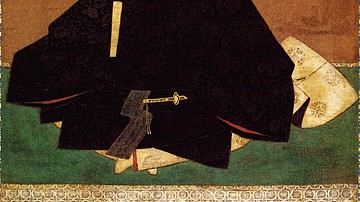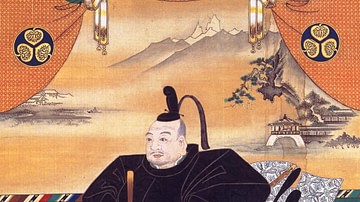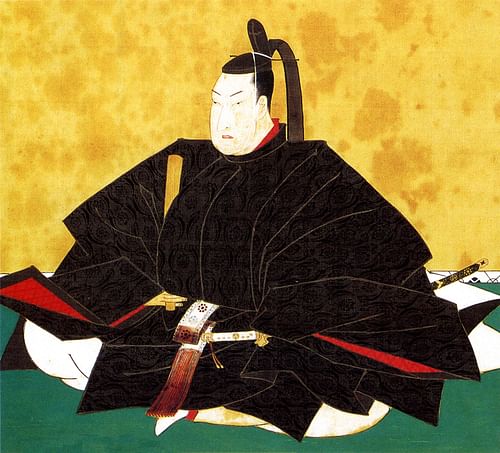
Tokugawa Tsunayoshi (1646-1709) governed Japan as the fifth shogun of the Edo period (1603-1876). He has often been ridiculed as the 'dog shogun' because of the laws he enacted to protect the lives of animals. Economically, however, the period of his rule was one of prosperity, and culturally, it was one of the most brilliant in Japanese history.
Early Years
Tsunayoshi was the son of the third shogun, Tokugawa Iemitsu, by one of his concubines. Iemitsu died when Tsunayoshi was only five, and his elder brother Ietsuna (1641-1680) became the fourth shogun. Ietsuna himself was only ten when this happened, so power was in the hands of regents who governed on his behalf. In 1661, Tsunayoshi became the daimyo of the Tatebayashi domain in modern-day Gunma Prefecture. When Ietsuna suddenly died in 1680, Tsunayoshi became shogun. In his early years as shogun, Hotta Masatoshi (1634-1684) played an important role in running government affairs as he had done under Ietsuna. In 1684, however, Masatoshi was murdered by one of his relatives, and this provided Tsunayoshi with the opportunity to promote a number of his own supporters to important positions. From then on, government policies more closely reflected Tsunayoshi's own ideas. The period of his rule was one of cultural brilliance, but this was the result not so much of his actions but broader changes in Japanese society.
Changes in Japanese Society
In the period from 1600 to 1720, the population of Japan roughly doubled from around 15 to 30 million. This dramatic increase was brought about by the end of the civil wars that had plagued Japan in the 140 years leading up to the establishment of the Tokugawa shogunate in 1600. As peace settled in the country, it was possible for people to put more effort into developing agriculture. New land was opened up for growing rice and other crops; irrigation systems were improved, and new farming techniques developed. The increased production of commodities such as paper, wax, cloth, and salt led to the expansion of trade. Initially, this was just local, but as the transport networks on land and sea developed, increasingly this trade was interregional and later national in nature.
The increase in population led to the growth of towns and cities. In many of the approximately 270 domains into which Japan was divided, there was a castle surrounded by a castle town. It was government policy for the warrior class, which was about 7% of the population, to live in these towns. The warriors needed various kinds of goods and services, and this in turn drew commoners to urban areas. By the end of the 17th century, Edo (modern-day Tokyo) had a population of around one million people. In Western Japan, Osaka developed as a large commercial center. In contrast to Edo, which was a city dominated by warriors, Osaka was a city of merchants.
Under Tokugawa law, people were divided into four hereditary classes. Warriors were at the top because they governed society. Next came the farmers because they produced the food people needed. Below them were artisans who were valued because they made things. At the bottom were merchants who were not held in high regard because it was thought they did not contribute anything and simply made money from other people's work. As time passed, however, this social order became subverted. As a commercial economy developed, warriors tended to become poorer and merchants wealthier. The government passed various kinds of laws to try and stop this, but none of these was effective.
Genroku Period
Reflecting this social change, a new kind of urban culture developed. The high point of this new culture was in the Genroku period from 1688 to 1704. In historical times in Japan, years were calculated according to the reign period of an emperor, that is, the period during which a particular emperor of Japan was on the throne. Auspicious names were used for these reign periods in the hope that this would bring good luck.
Not only was the Genroku period one of comparative affluence but it was also a time when some of Japan's greatest writers were active. In the field of poetry, Matsuo Basho (1644-1694) developed haiku poetry to a new level of sophistication. In literature, Ihara Saikaku (1642-1693) wrote novels that vividly portrayed the lives of warriors and townsfolk. In the field of drama, the kabuki (which used real actors) and bunraku (which used puppets) theatres developed. Chikamatsu Monzaemon (1653-1724), Japan's greatest playwright, wrote many plays for both forms of theatre at this time.
The literature these writers produced allows us to get a much better understanding of Japanese society than is possible for earlier periods. The entertainment areas centered on theatres and brothels were one of the main features of urban life at this time. The lifestyle associated with these places was referred to as the ukiyo, which means "floating world". Hishikawa Moronobu (1618-1694) played an important role in developing a new art form called ukiyo-e, which means "pictures of the floating world". In English, these are referred to as woodblock prints, and they provide stunning, although highly-stylized, images of Japanese people and places at the time.
The Spread of Neo-Confucianism
The 17th century was also a period of innovation in the intellectual world. Before 1600, Shinto and Buddhism were the dominant religions, but in the 17th century, Confucianism became influential in Japan. Confucianism, as it originally developed in China in the 5th century BCE, was little more than a system of ethics related to how individuals and rulers should behave. After the spread of Buddhism to China from India in the 2nd century CE, however, Confucian intellectuals began to develop a much more sophisticated set of ideas. In the Song period (960-1279) thinkers like Zhu Xi (1130-1200) developed a comprehensive theory of the individual, society and the universe, known as Neo-Confucianism.
One of the central ideas in Neo-Confucianism is that human nature is essentially good, but that goodness can be clouded by engagement with the world. To restore the original goodness, it is necessary for individuals to engage in self-cultivation. Different philosophers had different ideas about what constituted self-cultivation and how to go about it. Some of these Neo-Confucian ideas were introduced to Japan in the Kamakura Period (1185-1333) and the Muromachi Period (1333-1573) along with new types of Buddhist thought. It was only in the early Edo period, however, that Neo-Confucianism developed as a separate school of thought distinct from Buddhism. Early Confucianists were treated with suspicion by the government because they were thought to be advocating some form of Christianity, which the Tokugawa had banned in the 1620s. Gradually, however, a class of independent scholars appeared that made a living by teaching Confucianism.
It was once thought that Confucianism was simply a conservative ideology that supported the hierarchical social order imposed on Japan by the Tokugawa. More recent research, however, has pointed out that this was not the case. In China, Confucianism was part of the state apparatus. In order to become a government official, it was necessary for people to pass civil service examinations of imperial China based on an understanding of the Confucian classics that was taught in government-sponsored schools. Although, in reality, only those from the wealthy elite could achieve this, in theory, Chinese government appointments were based on merit.
In Japan, however, the situation was completely different. The government was in the hands of a hereditary military aristocracy, and any suggestion that things should be otherwise was frowned upon. In this regard, one example of a scholar who got in trouble was Yamaga Soko (1622-1685). Yamaga was concerned by the fact that, since the coming of peace to Japan, warriors had lost their traditional role as fighters. He argued that, as the ruling class, warriors now had the obligation not only to govern but also to act as role models for other members of society. To do this, they should engage in self-cultivation in the fields of both military training and the literary arts. Soko’s ideas reflected the fact that, since the end of the civil wars, Japanese society had undergone a profound change.
Edicts on Compassion for Living Things
Early Tokugawa shoguns like Ieyasu and Hidetada had little interest in this kind of thinking as they were, above all, fighting men. In contrast, Tsunayoshi, who as a child had developed an interest in literature and religion, seemingly under his mother's influence, actively promoted Confucianism. It was his desire to improve the moral standards of the population that led him to introduce some of the laws for which he is principally remembered today.
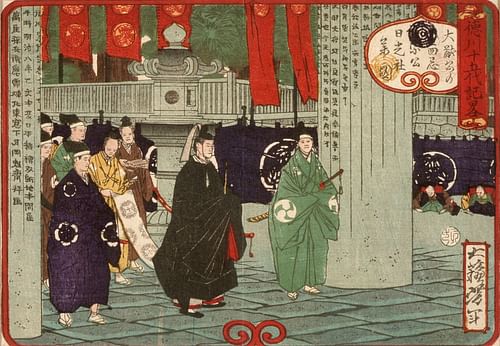
He started with laws requiring people to provide assistance to sick travellers and abandoned babies (of which, it seemed, there were many at the time). Later, however, he issued laws prohibiting people from hurting any living creature. These laws were especially applied to mistreating dogs and harsh penalties were introduced. As a result, the number of dogs in Edo multiplied greatly, and finally, special kennels had to be constructed in the suburbs to house them. These were the laws that led to his nickname, the 'dog shogun', and they have also caused some historians to doubt his sanity.
The Ako Incident
The most famous event that took place during the rule of Tsunayoshi was the Ako Incident. In 1701, the Lord of Ako (a domain in western Japan), Asano Naganori, attacked an official called Kira Yoshinaka within Edo Castle while preparing for a court ceremony. The motive for the attack is not known. Kira was only slightly injured, but disturbing the peace in this fashion was a capital offence. Asano was ordered to commit seppuku, which was the way warriors were executed at the time. His domain was also confiscated, and this meant his retainers became ronin or masterless warriors.
Subsequently, Asano's chief retainer, Oishi Yoshio, organized a secret plot against Kira because he believed he was responsible for the death of Asano. The reason he thought this is not clear because it was Asano that had attacked Kira in the first instance, not the other way around. Also, it was the government that sentenced Asano to death, not Kira. About two years later, he and his followers carried out a surprise attack on Kira's mansion in Edo and killed him. His severed head was taken to Sengakuji Temple where Asano was buried. There the plotters waited until the authorities arrived. They were arrested and, after an investigation by government officials, they were also ordered to commit seppuku. This verdict was important because it shows that, despite the retainers demonstrating warrior-like loyalty towards their former lord, the government was not willing to tolerate random acts of violence.
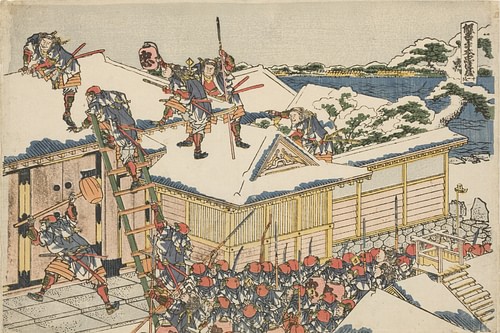
The Ako Incident is one of the most misunderstood events in Japanese history. In 1748, about 40 years after the incident took place, a play called Chushingura was performed in the bunraku theatre. This has been translated into English as A Treasury of Loyal Retainers, although it is more commonly known as The Story of the Forty-Seven Samurai. It is generally thought to be an account of the Ako Incident but is, in fact, largely made up. People tend to confuse the Ako Incident, which was a real event, with Chushingura, which was a work of fiction.
Engelbert Kaempfer's Visit to Japan
One last point of interest related to the rule of Tsunayoshi concerns the visit of Engelbert Kaempfer (1651-1716) to Japan. During the Edo period contact between Japan and foreign countries was severely restricted. The only Europeans allowed in were Dutch traders who were largely confined to Nagasaki. Kaempfer was a German naturalist who visited Japan aboard a Dutch boat in 1691. He spent two years in Japan and wrote a book describing conditions there. It was translated into English and published after his death. For more than one hundred years, this book was the main source of general information about Japan for Europeans. It is still of interest today because it describes what Japan was like when Tsunayoshi was shogun from a European perspective.

